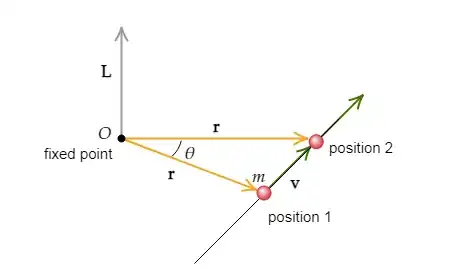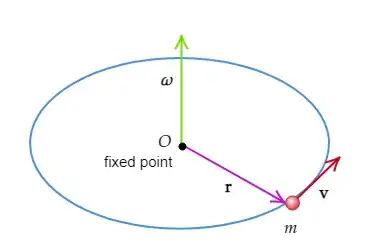This question is created to get additional information for my students from a high school.
We know that the angular moment is given by:
$$\mathbf{L}=\mathbf{r}\times \mathbf{p}=m(\mathbf{r}\times \mathbf{v}) \tag 1$$ where: \begin{array} {cc}\mathbf{p}=m\mathbf v \quad \text{it is the momentum with a velocity } \mathbf v \\ \mathbf{r} \quad \text{ it is the displacement vector} \\ \hline \end{array}
This vector $\mathbf{L}$ is perpendicular to the plane identified by the two vectors $\mathbf{r}$ and $\mathbf{v}$ and is outgoing from the sheet plane.
The moment of a force $\mathbf{M}$ or $\boldsymbol{\tau}$ applied to a rigid body ($\mathbf{F}$) gives the rotation of it with respect to a fixed point (for example $O$) or respect to a fixed axis,
$$\mathbf{M}=\mathbf{r}\times \mathbf{F} \tag 2$$ In addition
$$\frac{\sum \Delta \mathbf{L}}{\Delta t}=\mathbf{M}$$
The definition of momentum of a force I believe is easily intuitable. But could the definition of angular momentum be as follows?
The moment of a force generates the rotation while the angular momentum gives the intensity of the rotation?
I know, but not my students that
$$\mathbf{v}=\boldsymbol{\omega}\times \mathbf{r} \tag 2$$ and
$$\mathbf{L}=I\boldsymbol{\omega} \tag 3$$ where $I$ is the moment of inertia.
As can I easily derive the $(3)$ starting from the $(1)$ and to have a proof from the $(1)$ that $\mathbf v =\boldsymbol \omega \times \mathbf r$?
PS: I cannot use mixed products or double vector products, or in general the derivative, integral - my students are 16 years old.
Addendum: I have not yet explained work, conservation laws, and rotational dynamics.

